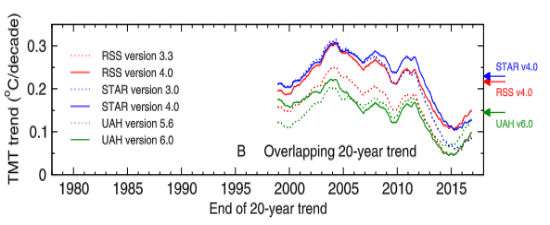Scott Pruitt Refuted on 'Leveling Off' of Global Temperature Trends?
It depends on what the meaning of the word "hiatus" is.

A new study purports to refute new Environmental Protection Agency chief Scott Pruitt's claim that "over the past two decades satellite data indicates there has been a leveling off of warming, which some scientists refer to as the 'hiatus'." According to the paper, which was published last week in Nature Scientific Reports, "Satellite temperature measurements do not support the recent claim of a 'leveling off of warming' over the past two decades."
The researchers, led by Lawrence Livermore National Laboratory climate modeler Benjamin Santer, draws on the global temperature trends of three different satellite datasets for the mid-troposphere—the troposphere being the lowest, densest part of Earth's atmosphere, where most weather changes occur—from 1979 (when the records begin) to December 2016. One dataset, from the University of Alabama at Huntsville (UAH), shows temperatures rising 0.09 degree C per decade; adjusting for measurements that are distorted by falling lower stratospheric temperatures, Santer and his colleagues calculate that the figure should actually be 0.142. The second dataset, from Remote Sensing Systems, seems to show a hike of 0.094 degrees C per decade; with the paper's adjustments, that becomes 0.199. And the National Oceanic and Atmospheric Administration appears to indicate an increase of 0.128 degree C per decade; the paper adjusts that to 0.202.
UAH climatologist John Christy argues in an email response that Santer's adjustment process "actually exaggerates the tropospheric warming rate (which is why we do not use it)." But his biggest problem with the study involves how those numbers are used, not how they're generated.
In their paper, Santer and his colleagues compare those real (although adjusted) temperature data with 36 climate model outputs that are supposed to show how global temperatures would have evolved during the past 38 years in the absence of accumulating greenhouse gases in the atmosphere. Such a comparison only works if the models are right about how much the climate would naturally vary in the absence of extra greenhouse gases. In Christy's words, it "depends on climate model natural variability being correct."
That could be a problem: "Model-generated natural variability is known to be less than real variability - this makes it easier for small trends in the observations to appear to be significant when in fact Mother Nature can produce large trends on her own. It's a real apples and oranges comparison - real data being tested against model-generated variability."
Earlier this month, another study in Nature recognized that the global warming hiatus that purportedly occurred from 1998 to 2015 has been defined differently in different sections of the scientific literature: It has been variously described as (1) no discernible increase in global average temperature, (2) a dramatic slowdown in the increase in warming, or (3) a slower increase than projected by climate computer models. If the Santer team's conclusions are correct, they have actually confirmed the second definition. Take a look at this chart from their paper:

As Christy points out, the Santer team's tropospheric "trends ending in 2004 were two to four times the value for trends ending in 2015 - i.e. supporting Pruitt's statement that trends were 'leveling off' compared with earlier periods." The upturn in temperatures at the end is the result of the natural boost in global average temperatures following a big El Niño in 2015 and 2016.
What about that third definition—the idea that global average temperature increases are lower than the climate models project? Oddly, another team of researchers led by Santer published a study in the January Journal of Climate that reached exactly that conclusion. That paper found that once temperature data are adjusted, the climate models are on average 1.7 times warmer than observed global temperature trends.
Christy stands by his March 2017 testimony at a hearing of the U.S. House Committee on Science, Space & Technology, which focused on trends in the tropics, where all models project significant man-made warming in the troposphere. Since 1979, he explained, averaging the global observational data gives you a warming trend of 0.117 degree C per decade; the projected global trend for 102 climate models was 0.216 degree C per decade. In other words, the models have been running about two times hotter than the data:

So if Pruitt meant that there has been no discernible increase global average temperatures for the past 20 years, he would be wrong. Still, as Christy notes, it seems odd to make "a politician's ambiguous statement" the focus of a formal paper. "If this was appropriate," he observes acerbically, "Al Gore would have been destroyed in the scientific literature 25 years ago."


Show Comments (112)